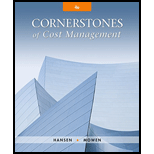
St. John’s Medical Center (SJMC) has five medical technicians who are responsible for conducting cardiac catheterization testing in SJMC’s Cath Lab. Each technician is paid a salary of $36,000 and is capable of conducting 1,000 procedures per year. The cardiac catheterization equipment is one year old and was purchased for $250,000. It is expected to last five years. The equipment’s capacity is 25,000 procedures over its life.
At the beginning of the second year, an HMO from a neighboring community approached SJMC and offered to send its clients to SJMC for cardiac catheterization provided that the charge per procedure would be $550. The HMO estimates that it can provide about 500 patients per year. The HMO has indicated that the arrangement is temporary—for one year only. The HMO expects to have its own testing capabilities within one year.
Required:
- 1. Classify the resources associated with the cardiac catheterization activity into one of the following: (1) committed resources, or (2) flexible resources.
- 2. Calculate the activity rate for the cardiac catheterization activity. Break the activity rate into fixed and variable components. Now, classify each activity resource as relevant or irrelevant with respect to the following alternatives: (1) accept the HMO offer, or (2) reject the HMO offer. Explain your reasoning.
- 3. Assume that SJMC will accept the HMO offer if it reduces the hospital’s operating costs. Should the HMO offer be accepted?
- 4. Jerold Bosserman, SJMC’s hospital controller, argued against accepting the HMO’s offer. Instead, he argued that the hospital should be increasing the charge per procedure rather than accepting business that doesn’t even cover full costs. He also was concerned about local physician reaction if word got out that the HMO was receiving procedures for $550. Discuss the merits of Jerold’s position. Include in your discussion an assessment of the price increase that would be needed if the objective is to maintain total revenues from cardiac catheterizations experienced in the first year of operation.
- 5. Chandra Denton, SJMC’s administrator, has been informed that one of the Cath Lab technicians is leaving for an opportunity at a larger hospital. She met with the other technicians, and they agreed to increase their hours to pick up the slack so that SJMC won’t need to hire another technician. By working a couple hours extra every week, each remaining technician can perform 1,050 procedures per year. They agreed to do this for an increase in salary of $2,000 per year. How does this outcome affect the analysis of the HMO offer?
- 6. Assuming that SJMC wants to bring in the same revenues earned in the cardiac catheterization activity’s first year less the reduction in resource spending attributable to using only four technicians, how much must SJMC charge for a procedure?
Trending nowThis is a popular solution!

Chapter 17 Solutions
Cornerstones of Cost Management (Cornerstones Series)
 Cornerstones of Cost Management (Cornerstones Ser...AccountingISBN:9781305970663Author:Don R. Hansen, Maryanne M. MowenPublisher:Cengage Learning
Cornerstones of Cost Management (Cornerstones Ser...AccountingISBN:9781305970663Author:Don R. Hansen, Maryanne M. MowenPublisher:Cengage Learning
